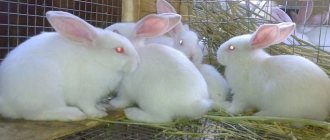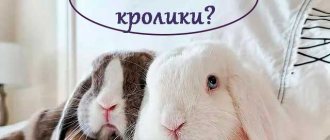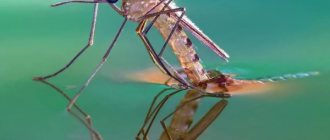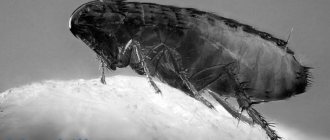Expert opinion
Dobryshev Sergey Anatolievich
Professional rabbit breeder and hare breeder with 30 years of experience
In order to better understand the worldview of your long-eared pets, you need to understand how rabbits see. The structure of the visual organs of rabbits differs from that of their owners, therefore they see their surroundings somewhat differently. This is necessary to know in order to successfully care for them.
Difference from man
In humans, the eyes are located at the front of the head. This arrangement was formed during evolution. Primates obtained food using their hands. In order to see future food and, for example, pick it, it was necessary to be able to examine it itself and the place where it is located, both near and at a distance.
Wild rabbits had a different task. The main thing for them was the opportunity to dodge numerous predators, for whom they themselves could become tasty food. If they had to turn around to look at their surroundings from the side and behind, then precious seconds would be lost.
The location of rabbits' visual organs on both sides of the head provides them with an almost 360-degree view. Rodents are especially good at distinguishing objects located in the distance.
Vision in the dark
Rabbits are vulnerable to attack by many predators during the day, so they often go out in the dark to search for food. The periods of greatest activity for small animals are evening and early morning. Like any twilight animal, the eyes of a rabbit allow you to clearly see objects around you even in low light. In addition, it is no secret that in nature long-eared animals live in burrows and spend most of the day in the dark.
However, the fact that rabbits see much better at night than during the day cannot be regarded as a need to keep animals in pitch darkness. Studies have shown that when there is a lack of lighting, biological processes in animals slow down, and young animals mature and grow less well. Rabbits do not spend much time in burrows: this is a place for sleeping, sheltering and nursing their offspring. For the rest of their lives they are exposed to light.
Structure of the eye
The eye structure of long-eared animals is not particularly different from other animals. Rabbits' eyes are large, convex, and ball-shaped. The eyeball located in the orbit is connected to the brain via the optic nerve.
Features include the presence of a third eyelid located in the inner corner of the eye. Its function is to protect the lacrimal glands.
What colors do rabbits see?
The human visual organs are designed in such a way that they are able to perceive the world around us in all its abundance of colors. Thanks to the cones and rods that are found in the eyeballs, people distinguish between three primary colors:
- red;
- green;
- blue.
People distinguish three primary colors, but rabbits only two
Unlike people, long-eared pets have a more primitive visual apparatus; they are able to distinguish only two colors - blue and green.
Nature made sure that rabbits could recognize the approach of danger in time and hide from it. Their organs of vision differ from human ones in their structure and location, but they cannot be considered imperfect. The visual apparatus of eared animals operates in conjunction with other senses - touch, smell and hearing, which allows animals to navigate well in space even in the dark.
Flaws
Rabbit vision, despite all the advantages, also has some disadvantages:
- Presence of a blind spot. Animals are able to see everything that is on the side and behind them, but they are deprived of the opportunity to see what is located directly in front of them.
- Lack of clarity of what is seen. Even in good lighting, pictures will be slightly blurry.
Even if you put his favorite treat - a carrot - in front of a rabbit, he will feel it rather than see it. A rabbit can also recognize objects in front of it using its sense of touch – its antennae. In order to see them, you have to turn sideways. With this movement, you should not think that your pet has vision problems.
Expert opinion
Dobryshev Sergey Anatolievich
Professional rabbit breeder and hare breeder with 30 years of experience
Important! Blurry images can cause the rabbit to not recognize its owner and hide in the corner of the cage.
How do rabbits see?
Many rabbit owners sometimes notice that something is wrong with the eyesight of their charges. Either they stop seeing the food right under their noses, or they absolutely do not pay attention to their owner, as if they are seeing her for the first time. Of course, in such situations, breeders have a question: is everything okay with their pet? And in general, how do rabbits see? Or maybe the problem is related to the anatomical features of his vision? If you are one of those people who is looking for answers to these questions, then I suggest you read the materials in this article.
RABBIT EYES
Let's figure out how a rabbit's eyes are structured and what is special about the vision of these animals.
BUILDING FEATURES
The eyeball of rabbits is large and spherical. Its structure is no different from the eyeballs of many other animals. The eyeball is located in the orbit and is connected to the brain via the optic nerve. It is covered by three eyelids: the traditional upper and lower ones, and in the inner corner of the eye there is another eyelid. They need the third eyelid to protect the sebaceous glands. The lacrimal gland is located in the temporal corner of the eye. Seven muscles are responsible for the movement of the organs of vision: 4 rectus muscles, 2 oblique muscles and 1 retractor of the eyeball. The surface of the eye is covered with a thick coating, which helps moisturize and preserve the apple. This is also why rabbits blink very rarely.
HOW RABBIT SEE
Rabbits are born blind. Their eyes open only at two weeks of age. Rabbits have monocular vision. This means that animals examine objects that fall into their field of vision with one eye. Rabbits are able to examine the area around them at 360°. Since the eyes of this animal are located on the sides, it is able to see a lot around, but, alas, the rabbit cannot see what is under its nose. If a rabbit is looking straight ahead, the area in front of it will be what is called a “blind spot.” As a result, in order to examine an object located in this zone, the rabbit needs to turn its head. Nature created this structure of the visual apparatus for rabbits for self-preservation. They can notice an approaching predator from afar and within a wide radius, and manage to hide or run away from it in a timely manner.
IT IS IMPORTANT! Rabbits can often develop eye diseases. Signs such as excessive lacrimation, discharge from the conjunctiva, sticking and swelling of the eyelids, clouding of the lens, itching, and loss of vision should alert you. Self-medication will not help here. You need to urgently contact a veterinarian. Only he is able to make the correct diagnosis and prescribe the correct treatment.
CAN RABBIT SEE IN THE DARK?
Rabbits have excellent vision both during the day and at night. And yet, they see differently from people - their picture is blurry (not clear). There is an opinion that rabbits see their owner as a large spot. And if the owner picks up some large object that covers part of his body, the animal will not recognize it, since the owner’s outline will be different. Rabbits are nocturnal, so they can eat well in complete darkness. For their vision, there is no difference whether it is light at the moment or pitch darkness. They are always comfortable. It is wise nature that has endowed rabbits with such a feature of vision due to the fact that they live in burrows underground, and the peak of activity occurs at twilight and early morning. And yet, despite the fact that rabbits navigate well in the dark, they should not be left for a long time without light. Due to a lack of lighting, the productivity of rabbits decreases and the growth of young animals slows down.
DO RABBIT SLEEP WITH EYES OPEN?
Rabbits sleep with their eyes slightly open, that is, their eyelids do not close completely. These animals are very timid, so at the slightest noise or movement they instantly wake up. But if a rabbit lives in an apartment long enough, he gets used to the calmness and then he can fall into a deep sleep, during which his eyes are completely closed. They like to sleep in secluded corners or lounge imposingly in the middle of the cage.
Did you know? Despite some external similarities and being classified as one family, rabbits have clear differences from hares. The main ones are that baby rabbits are born blind and bald, and baby hares are born covered with fur and have eyes that are already open and can see. Another significant difference is that rabbits live in underground burrows, while hares live in above-ground nests. And hares, unlike rabbits, could not be tamed.
Monocular vision has both pros and cons. The advantages include excellent visibility – almost 360° and the ability to spot a predator from afar. The main disadvantages are the inability to see objects located directly under the animal’s nose, and the lack of image clarity. Knowing these features, the owner will not be surprised when his pet does not react to the food placed in front of him. In order for him to see the food, the tray with food should be placed to the right or left of the animal’s head. So, the owner of rabbits should remember that their vision is arranged in a special way.
This vision allows rodents to evaluate objects with one eye and is completely different from, for example, a cat or a dog's vision. Birds and horses also have monocular vision.
Did you know? Two males, Ralph and Darius, compete for the title of the largest rabbit in the world. The first at 4 years old reached a weight of 25 kg and a length of 130 cm. The second had the same height and weighed just over 22 kg.
To fully perceive everything that surrounds them in this world except their eyes, they use their nose, mustache and ears. Therefore, they will quickly find what is located directly in front of them in the “blind spot” using smell or touch, rather than vision.
You might be interested
Advice for beginning rabbit breeders
Every beginning rabbit breeder (amateur rabbit breeder) dreams of healthy, highly productive rabbits growing and developing safely on his mini farm. Therefore, the main headache for a rabbit breeder is the correct and timely treatment of sick rabbits...
Forgotten folk remedies for treating rabbits. Kerosene for rabbits
Any rabbit breeder is interested, first of all, in the environmental friendliness of his meat, so he does not stuff his rabbits with medications from a veterinary pharmacy. In my articles I have already written about the treatment of rabbits with folk remedies -...
Making homemade soap from rabbit fat
Anyone can make soap at home from rabbit fat. This soap is ecological, healing and easy to make. Only a rabbit breeder knows the value of rabbit fat. We are not talking about the market price, of course, but...
How to protect rabbits from mosquitoes
Summer is in full swing and it's time to talk about small and evil mosquitoes that cause colossal damage to rabbit farms. Today I will tell you about the facts and scale of the sabotage of these flying bloodsuckers, and...
The benefits of rabbit fat
Rabbit fat – great taste and medicine in one spoon!!! You won’t find practically anything about rabbit fat, even on the Internet. And all because they know almost nothing about him...
Why do rabbits have three eyelids?
Rabbits blink only 10-12 times per hour. This is done so that they can always keep an eye out for predators. After all, rabbits are the preferred food source for countless carnivores, including wolves, foxes, hawks and even humans. This means they must be escape artists to survive.
For this purpose, there is a third eyelid that rabbits have - the nictitating membrane. To stay one step ahead of predators, rabbits must first see them coming.
The nictitating membrane allows rabbits to see even when they are sleeping. This is because it is transparent; once the index membrane is in place, rabbits are allowed limited vision, motion detection, etc.
At the same time, the nictitating membrane secretes fluid to keep the rabbit's eyes moist. This way, when they wake up, their vision is not impaired from sleep. They can quickly spot danger and run away.
You can see why muscle membrane health is so important. They rely on it to sleep normally and protect themselves at night, day, dawn or dusk.
Color perception
It seems completely natural for a person to look at the world in all its colors. The world is filled with a wide variety of shades of blue, red, green. But it’s not like that for our students. For many years, experts believed that the rabbit sees the world like a black and white movie. There are only shades of gray. But scientists were able to determine that this was not the case. It has been proven that the long-eared eye is able to distinguish between green and blue colors. Accordingly, all their shades and intersections. This is not such a rich world as a person’s, but also not as poor as a solid gray one. However, the question remains open of how animals perceive these colors. Today it is difficult to talk about this.
Another feature of rabbits’ vision can be considered that they practically do not close their eyes during sleep. It is difficult to say whether the video signal is being processed at this time or not, but they sleep very lightly. The slightest movement nearby and the animal wakes up.
From what has been said, it is clear: in order to understand how our pets perceive the world, we need to get acquainted with the characteristics of their senses. This will undoubtedly help you better manage your pets' behavior. Makes communication with them more interesting.











